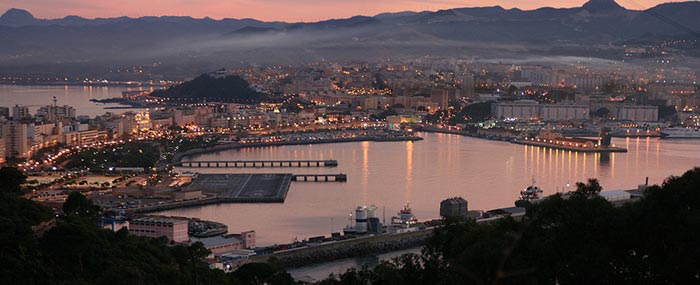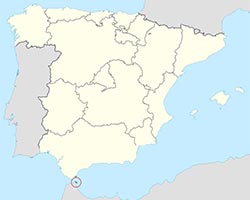Autonomous Enclave of Cueta

Ceuta is not actually an autonomous region, but a Spanish autonomous city sitting on the African coast in the Straits of Gibraltar. Although it was granted the status of autonomous region under the constitution in 1978, it has chosen to remain under the AndalucIan authorities in the matters of higher education, the Supreme Court and the diocese.
The city is set on a tiny peninsula which itself comes off a very large, Moroccan peninsula called Tingitana. Being a peninsula, it has water on three sides, and borders on the Straits of Gibraltar (north), the Mediterranean Sea (east and south) and Morocco (west).
It covers a surface of 18.5 km2 and has a population of 84.959 (2017), which gives it an elevated population density: 4,592.38 souls per square kilometer, on par with the major Spanish cities.
The highest point in Ceuta is Mount Anyera (349 m above sea level).
The city has always been considered the divider between the Atlantic Ocean and the Mediterranean Sea, and the water has created two bays: the North Bay, which looks towards the Spanish peninsula and the South Bay, which faces Morocco.
History
The earliest evidence of human settlements in Ceuta dates back to 250,000 B.C., and periods of the city’s history go hand in hand with the history of the Spanish peninsula, whereas others deviate. Due undoubtedly, to the fact that although Ceuta is part of Spain, it is situated on a different continent.
With its strategic position overlooking the Straits of Gibraltar, Ceuta has always been a coveted area, and an amazing amount of dynasties, kingdoms and caliphates from Europe and the Arab world have conquered, re-conquered, put the city under siege or laid claim to it.
Some of the occupations the territory has been under have lasted less than a year, and at one point, in the 13th century, the city even managed a brief period of independence. The Independent City of Ceuta lasted only three years, though, from 1233 - 1236.
The Ceuta that we know today started taking shape when Portugal’s King landed on its shore on 21st August 1415. He and his men conquered the city and this was the beginning of a long period of peace and stability.
 However, when the young King Sebastian of Portugal died in the battle of Alcácer Quibir in 1578 there was no heir apparent and the Portuguese crisis of succession started. It ended when Felipe II of Spain gained control of the country in 1580, and Ceuta, along with Portugal, was ruled by the Spanish crown.
However, when the young King Sebastian of Portugal died in the battle of Alcácer Quibir in 1578 there was no heir apparent and the Portuguese crisis of succession started. It ended when Felipe II of Spain gained control of the country in 1580, and Ceuta, along with Portugal, was ruled by the Spanish crown.
When Portugal finally regained its independence in 1640, the authorities of Ceuta decided to remain with the Spanish King Felipe IV and under Spanish rule, and this has been its status ever since.
However, this did not mean peace and bliss forever after for Ceuta. From 1694 to 1791 Morocco put the city under siege no less than four times - the longest, and one of the longest sieges in history, went on for over 25 years.
Another hiccup for Ceuta came when the British conquered Gibraltar in 1704. All the supplies that Ceuta received from the European continent came through Gibraltar, and the city found itself cut off from its lifeline to mainland Spain.
Through all this Ceuta has remained under Spanish rule, and when the constitution of 1978 took effect, the city became the Autonomus City of Ceuta.
As the city covers a very small area, the economy is heavily dominated by the service sector, as there is very little space for agriculture or industry. Fishing is, in the nature of the geographical position of Ceuta, the most important industry together with construction.
Ceuta has the status of free port, which of course attracts a lot of commerce.
The climate is mild, especially in winter, and because ofthe humidity from the Atlantic and the difference in temperatures between the waters on either side of the Straits of Gibraltar, the territory has abundant rain, up to 600mm per year, most of which falls in the winter months. The summers are hot and dry.
Ceuta is becoming a popular tourist destination with its mild climate, its abundance of historic monuments marking the events of its tumultuous past and its many restaurants offering a vast variety of Spanish and Arabic dishes.


